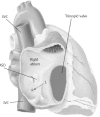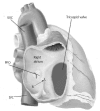Closing patent foramen ovale in cryptogenic stroke: The underscored importance of other interatrial shunt variants
- PMID: 26131337
- PMCID: PMC4478567
- DOI: 10.4330/wjc.v7.i6.326
Closing patent foramen ovale in cryptogenic stroke: The underscored importance of other interatrial shunt variants
Abstract
Recent trials and metanalysis even not fully conclusive and still debated, at least suggested that mechanical device-based closure of patent foramen ovale (PFO) is more effective than medical therapy in prevent recurrence of stroke. In a proportion ranging from 20% to nearly 40% of patients in literature, PFO is associated to atrial septal aneurysm (ASA): ASA is a well-known entity often associated with additional fenestration. Additionally small atrial septal defects ("Flat ASD") can present with signs of paradoxical embolism and cannot be easily detected by transthoracic echocardiography or even by transesophageal echocardiography and are usually discovered by intracardiac echocardiography at the moment of transcatheter closure. This evidence might change potentially the anatomical diagnosis from PFO to fenestrated ASA or as we called it to "hybrid defect", being a bidirectional flow through a small ASD or/and an additional fenestration, often present. Despite the differences in anatomy, pathophysiology and haemodynamic paradoxical embolism may occur in both entities and also may be the first appearance of fenestrated ASA. Because some overlapping do really exist between PFO and hybrid defects, which are often not clearly differentiable by standard diagnostic tools, it is likely that a proportion of patients evaluated for potential transcatheter closure of PFO had actually a different anatomical substrate. These different anatomical and pathophysiologic entities have not been address in any of the previous trials, potentially having an impact on overall results despite the similar mechanical treatment. Neurologists and general cardiologists in charge of clinical management of PFO-related cryptogenic stroke should be aware of the role of hybrid defects in the pathophysiology of paradoxical embolism - mediated cerebral ischemic events in order to apply the correct decision - making process and avoid downgrading of patients with paradoxical embolism-related interatrial shunt variants different from PFO.
Keywords: Anatomy; Atrial septal defect; Echocardiography; Patent foramen ovale.
Figures



Similar articles
-
Transcatheter patent foramen ovale closure is effective in reducing migraine independently from specific interatrial septum anatomy and closure devices design.Cardiovasc Revasc Med. 2010 Jan-Mar;11(1):29-33. doi: 10.1016/j.carrev.2008.04.002. Cardiovasc Revasc Med. 2010. PMID: 20129358
-
Predictors of recurrent events in patients with cryptogenic stroke and patent foramen ovale within the CLOSURE I (Evaluation of the STARFlex Septal Closure System in Patients With a Stroke and/or Transient Ischemic Attack Due to Presumed Paradoxical Embolism Through a Patent Foramen Ovale) trial.JACC Cardiovasc Interv. 2014 Aug;7(8):913-20. doi: 10.1016/j.jcin.2014.01.170. JACC Cardiovasc Interv. 2014. PMID: 25147037 Clinical Trial.
-
Management of Patients with Patent Foramen Ovale and Cryptogenic Stroke: An Update.Cardiology. 2019;143(1):62-72. doi: 10.1159/000501028. Epub 2019 Jul 15. Cardiology. 2019. PMID: 31307049 Review.
-
Ignored Role of Paroxysmal Atrial Fibrillation in the Pathophysiology of Cryptogenic Stroke in Patients with Patent Foramen Ovale and Atrial Septal Aneurysm.Curr Cardiol Rev. 2024;20(2):14-19. doi: 10.2174/011573403X267669240125041203. Curr Cardiol Rev. 2024. PMID: 38367262 Free PMC article. Review.
-
Transcatheter Closure of Patent Foramen Ovale versus Medical Therapy after Cryptogenic Stroke: A Meta-Analysis of Randomized Controlled Trials.Cerebrovasc Dis. 2018;45(3-4):162-169. doi: 10.1159/000487959. Epub 2018 Mar 29. Cerebrovasc Dis. 2018. PMID: 29597192
Cited by
-
Paradoxical Embolism in a Patient with Patent Foramen Ovale; a Case Report.Emerg (Tehran). 2018;6(1):e50. Epub 2018 Aug 8. Emerg (Tehran). 2018. PMID: 30584566 Free PMC article.
-
Influence of the Valsalva maneuver on cardiac hemodynamics and right to left shunt in patients with patent foramen ovale.Sci Rep. 2017 Mar 7;7:44280. doi: 10.1038/srep44280. Sci Rep. 2017. PMID: 28266661 Free PMC article.
-
A Comparison of Transthroracic Echocardiograpy and Transcranial Doppler With Contrast Agent for Detection of Patent Foramen Ovale With or Without the Valsalva Maneuver.Medicine (Baltimore). 2015 Oct;94(43):e1937. doi: 10.1097/MD.0000000000001937. Medicine (Baltimore). 2015. PMID: 26512622 Free PMC article. Clinical Trial.
References
-
- Carroll JD, Saver JL, Thaler DE, Smalling RW, Berry S, MacDonald LA, Marks DS, Tirschwell DL. Closure of patent foramen ovale versus medical therapy after cryptogenic stroke. N Engl J Med. 2013;368:1092–1100. - PubMed
-
- Khan AR, Bin Abdulhak AA, Sheikh MA, Khan S, Erwin PJ, Tleyjeh I, Khuder S, Eltahawy EA. Device closure of patent foramen ovale versus medical therapy in cryptogenic stroke: a systematic review and meta-analysis. JACC Cardiovasc Interv. 2013;6:1316–1323. - PubMed
-
- Udell JA, Opotowsky AR, Khairy P, Silversides CK, Gladstone DJ, O’Gara PT, Landzberg MJ. Patent foramen ovale closure vs medical therapy for stroke prevention: meta-analysis of randomized trials and review of heterogeneity in meta-analyses. Can J Cardiol. 2014;30:1216–1224. - PubMed
-
- Pandit A, Aryal MR, Pandit AA, Jalota L, Kantharajpur S, Hakim FA, Lee HR. Amplatzer PFO occluder device may prevent recurrent stroke in patients with patent foramen ovale and cryptogenic stroke: a meta-analysis of randomised trials. Heart Lung Circ. 2014;23:303–308. - PubMed
Publication types
LinkOut - more resources
Full Text Sources
Other Literature Sources

